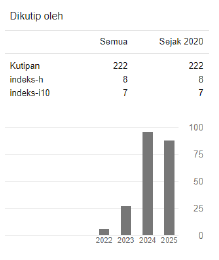The Effect of Using the U-Dictionary Application for Students’ Pronunciation on Grade Eight in Teaching Speaking at SMP Swasta Taman Asuhan Pematang Siantar
 https://doi.org/10.54012/ijcer.v2i3.220
https://doi.org/10.54012/ijcer.v2i3.220
 Abstract views: 259
Abstract views: 259
 PDF downloads: 303
PDF downloads: 303
Keywords:
Effect, Pronunciation, U-Dictionary, Teaching SpeakingAbstract
The objective of this research was to find out the effect of the U-Dictionary Application for the students’ pronunciation on grade eight in teaching speaking at SMP Swasta Taman Asuhan Pematang Siantar. The method used quantitative with quasi-experimental research method with pre-test and post-test design. Two classes provided the data: the experimental class and the control class. In this research, VIII-A was the experimental class, while VIII-B was the control class. There were 28 students in each class, for a total sample size of 56. The pre-test mean score for the experimental class was 64.75, whereas the mean score for the control class was 64.50. Conversely, the experimental class’s post-test mean score was 78.92, whereas the control class’s post-test mean score was 69.57. The data was then examined by the researchers using a t-test. The T-test showed a greater degree of significance (2,7 > 1.674) compared to the T-table. Results showed that using the U-Dictionary Application for students’ pronunciation on grade eight teaching speaking at SMP Swasta Taman Asuhan Pematang Siantar had a substantial impact. Ha was accepted and H0 was rejected.
Downloads
References
Burns, A. “Clearly Speaking: Pronunciation in Action for Teachers National Center for English Language Teaching and Research”. Macquaire University, Sydney NSW 2109, 2003.
Cresswell, J. W. Research Design: Qualitative, Quantitative, and Mixed Methods Approaches. (5 th ed). California: SAGE Publication, Inc, 2018.
Gay, L. R., Mills, G. E., & Airasian, P. Educational Research Competencies for Analysis and Applications, Tenth Edition. New Jersey: Pearson Merril Prentice Hall, 2012.
Hewings, Martin. “Pronunciation Practice Activities”. Cambrigde University, 2004.
Hornby. A. S. “Oxford Advanced Learner’s Dictionary of Current English”. London: Longman, 2005.
Hurlock, E. B. “Perkembangan Anak”. Jakarta: Penerbit Erlangga, 2007.
Pourhosein, Abbas. “ A Study of Factors Affecting EFL Learners’ English Pronunciation Learning and Strategies for Instruction”. International Journal of Humanities and Social Science: Vol 2(3), 2012.
Rahma, S., & Mubarok, H. Frozen Cartoon Film as a Learning Media to Improve the Students’ Pronunciation Ability. Jadila: Journal of Development and Innovation in Language and Literature Education. Vol 2(2): pp: 239–247, 2021.
Ramelan. “English Phonetics”. Semarang: IKIP Semarang Press, 2003.
Reinders, Hayo. Twenty Ideas for Using Mobile Phones in the Language Classroom. English Teaching Forum. United Kingdom, Vol 3: p. 20-33, 2010.
Saputri, T. Improving Vocabulary Mastery Through Flashcards in Sartika Kindergarten Surabaya. ATLANTIS PRESS: pp. 145, 2017.
Wiratman. “The effectiveness of using mobile learning dictionary toward students vocabulary mastery”. Lampung : University of Raden Intan Lampung, 2021.
Downloads
Published
How to Cite
Issue
Section
License
Copyright (c) 2024 Rut Maria Hutauruk, Leonita Maria Efipanias Manihuruk, Anita Sitanggang

This work is licensed under a Creative Commons Attribution-ShareAlike 4.0 International License.









